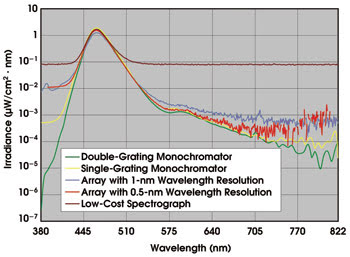Eric Nelson, Gamma Scientific
Although LEDs emit within narrow spectral windows, manufacturers and users alike often need to ensure that emission is both consistent and accurate, particularly for components used in biotechnical research, machine vision and communications. Several types of instrumentation claim to measure LED qualities, such as intensity, peak and dominant wavelength, and color accuracy, but different instruments measure different optical qualities with varying degrees of success. Not all instruments deliver the measurement accuracy that more stringent applications require.
High-quality photometers gauge intensity well, with less uncertainty than spectroradiometers, in most cases. The most important part of a photometer system is the detector/filter combination, which must align closely with the CIE Human Eye Response curve at all wavelengths. As many standards labs shift from lamp- to detector-based candela standards, photometer measurements will become even more accurate and repeatable. Assuming that they integrate well-characterized filters, photometric measurements can deliver less than 5 percent uncertainty for luminous intensity for about $6000.
Adequate spectroradiometers may cost more, but they are a necessity for performing accurate color measurements. For measuring LED color, however, it is essential that a spectroradiometer can finely resolve wavelengths better than 1 nm. Low-end instruments may provide wavelength resolutions of only 4 to 5 nm. Others resolve wavelength with greater accuracy but do not distinguish intensity very well because of limited dynamic range. Accurate LED color measurement relies on spectroradiometers that deliver good spectral resolution, high dynamic range and excellent stray-light rejection.

Different instruments measure color with varying degrees of accuracy, but unfiltered stray light can raise an instrument’s noise floor and conceal essential information. The smooth brown line captured with a low-cost CCD spectrograph, for example, indicates a peak 470-nm wavelength and flat intensity across the rest of the spectral range. As the other instruments demonstrate, however, the spectrograph’s noise floor is too high to detect intensity variations at longer wavelengths.
Dynamic range defines the ability to resolve different intensity levels at any given wavelength. An instrument with good dynamic range delivers high-resolution measurement of intensity according to wavelength. Measurements limited to intensity or wavelength, no matter how accurate, have a profound impact on the calculations of color vision software and produce results of less value than no data at all.
Eliminating stray light
Good stray-light rejection is even more important to accurate color measurement. The diffraction gratings that sort individual wavelengths inside spectroradiometric instruments always scatter some incident light. If any of this stray light impinges on the detector element, it can confuse the color software, which incorporates the scatter into its calculations and averages the X-Y chromaticity coordinates toward the middle of the CIE color map (i.e., white).
Specifications for color accuracy and stray-light rejection vary from one spectroradiometer supplier to the next. Unfortunately, there is no market standard as yet. It helps to observe how a supplier derived a specification.
Many suppliers establish color accuracy using an Illuminant-A tungsten source operating at 2856 K. Tungsten, a broadband white source, provides a nice smooth spectral curve. So, naturally, it is easy to derive a good, flat color measurement with even low-resolution instruments. The performance of these instruments may be different when measuring narrowband sources. If there is a question, it never hurts to ask the manufacturer to provide color measurement data.
Specifications for stray-light measurement are even more diverse. But again, narrowband sources provide a more accurate calibration. An infinitesimally small bandwidth is impossible to obtain, but a measurement of an emission line with a 1-nm bandpass should contain very little light 8 nm away from the emission line. Gamma Scientific of San Diego, for example, uses a 632.8-nm HeNe laser line to establish that its diode array offers minimal stray light 8 nm from the HeNe baseline. This level of stray-light rejection provides more than adequate accuracy for good color measurement.
The point that LED manufacturers and users should remember, however, is that instruments, like applications, have different demands. Accurate color measurement demands more sophisticated instruments — and users. If an LED’s intensity is the primary or only factor of interest, then photometers with well-defined filters are more than adequate.
Meet the author
Eric Nelson is senior physicist and sales manager for Gamma Scientific in San Diego; e-mail: [email protected].